Microbial,immune and antioxidant responses of Nile tilapia with dietary nano-curcumin supplements under chronic low temperatures
Momme F.El Bsuini ,Mome A.A.Zki ,Aelziz M.El-His ,Mome G.Elnfy ,Em H.El-Bilwy ,Amr I.Zinelin ,Mome F.A.Ael-Aziz ,Irim A.Aouels ,f,Irim T.El-Rtel ,Kumukni Mzenerez ,Ronik S.Srk ,Islm I.Tei
a Faculty of Agriculture,Tanta University,Tanta,31527,Egypt b King Salman International University,South Sinai,46618,Egypt
c Faculty of Agriculture,Alexandria University,Alexandria,21526,Egypt
d Animal Health Research Institute (AHRI-DOKI), Agriculture Research Center,Giza,12619,Egypt
e Fish Rearing Lab., Aquaculture Division,National Institute of Oceanography and Fisheries,Alexandria,21556,Egypt f Horticulture Department,Faculty of Agriculture,Damanhour University,Damanhur,22511,Egypt
g Department of Poultry Production,Faculty of Agriculture,Damietta University,Damietta,34517,Egypt
h Laboratory of Aquatic Animal Nutrition,Faculty of Fisheries,Kagoshima University,Kagoshima,890-0065,Japan
i Department of Aquatic and Fisheries Science,Mzuzu University,Mzuzu,Private Bag 201,Malawi
j Faculty of Aquaculture and Marine Fisheries,Arish University,Arish,45516,Egypt
Keywords: Nano curcumin Gastrointestinal microbiota Antioxidants Non-specific immune responses Temperature stress
ABSTRACT A 56-day feeding period was performed to investigate the possible impacts of dietary nano curcumin (0,50,100,150,and 200 ppm) on the growth,nutrient utilization,non-specific immune parameters,antioxidants in Nile tilapia under chronic low temperature (21.02 ± 0.11 ◦C).Fishes (n=225;Initial weight=4.39 ± 0.08 g/fish)were randomly stocked at 15 fish/tank for five experimental groups in triplicates.Under low-temperature circumstances,dietary curcumin in nano form showed no notable alteration in growth variable,nutrient efficiency,digestive enzymes efficiency,biometric indices,survival rates,and hematological components.Meanwhile,the serum of fishes with nano curcumin diets under low-temperature stress displayed higher total protein as well as lower glucose,cortisol,and total cholesterol compared with the control group.Moreover,fish fed nano curcumin diets displayed higher lysozyme and bactericidal activities compared to the control group and the best performance was found at dietary nano curcumin level of ≥100 ppm.Also,groups fed the basal diet demonstrated the poorest antioxidant capacity,and the best superoxide dismutase (SOD) and glutathione peroxidase (GPx) existed in fish with nano curcumin diets while the best catalase (CAT) efficiency occurred at higher nano curcumin levels≥100 ppm.In addition,higher counts of intestinal microbiota in terms of total bacterial count (TBC),total yeast and molds count (TYMC),and coliform were noticed in fish consumed the basal diet compared to groups fed on nano curcumin diets.In conclusion,incorporating nano curcumin at a level of ≥100 mg/kg diet (particularly at 150 mg/kg) improved a non-specific immune response,antioxidant,and healthier gastrointestinal microbiota in Nile tilapia under chronic low-temperature stress.
1.Introduction
Aquaculture has succeeded as a vital sector in providing a large portion of high-quality protein (Mzengereza et al.,2021;Shadrack et al.,2022).Nile tilapia is a widely distributed and farmed species owing to its remarkable value as a business (Gewaily et al.,2021;Lind et al.,2019).Tilapia is a good contender for semi-intensive and intensive farming practice since it can handle a wide range of growing conditions(Abdel-Latif et al.,2020;Manduca et al.,2020;Mengistu et al.,2020).However,rising fish under suboptimal or stressful circumstances has serious consequences for their health,metabolism,and physiological reactions (Xavier et al.,2020).Most tilapia species thrive best at temperatures range 25–28◦C and tilapia cannot endure temperatures below 10–12◦C for more than a few days,while reproduction ends at 22◦C and feeding decreases at 20◦C (Hassan et al.,2013;Wohlfarth &Hulata,1981).Despite its tropical origins,Nile tilapia is grown in many subtropical areas across the world,including southern Brazil,China,and Egypt,where output is limited during the winter months (Nobrega et al.,2020).The incompetence of tilapia to withstand cold temperatures,particularly in the winter,is a serious economic worry since it results in poor development and enormous death (Charo-Karisa et al.,2005).
Establishing possible tactics to ameliorate animals’ health and performance is critical for aquaculture sectors particularly under stressful conditions and the cornerstone of aquaculture success is effective management (Dawood et al.,2015).Antibiotics were extensively applied as a growth promoter,stress reliever,and remedy (Schar et al.,2021).Today,antibiotics and other synthetic chemicals are increasingly being replaced with environmentally benign ways capable of improving aquatic species’ health,performance,and,ultimately,assuring the safety and high quality of aquatic products (Dossou et al.,2021;Gewaily et al.,2021;Paray et al.,2021).Using functional feed additives and modulating the composition of the diet has become a widely accepted way for increasing the performance of aquatic animals (Dossou et al.,2021;Encarnação,2016;Sutili et al.,2018;Zaineldin et al.,2021).
Curcumin or diferuloylmethane[1,7-bis(4-hydroxy-3-methoxyphenyl)-1,6-heptadiene-3,5-dione] originated from turmeric rhizome (Curcuma longa),is a polyphenol highly vigorous botanical product with countless therapeutic potentials (Priyadarsini,2014).The beneficial impacts of turmeric and curcumin on human and animal health are well documented e.g.antibacterial,anti-cancer,anti-inflammatory,antioxidant,chemoprotective,gastroprotective,growth enhancer,hepatoprotective,and neuroprotective effects (Alagawany et al.,2021;Hewlings &Kalman,2017).Despite curcumin’s advantageous impacts,studies have revealed that consumption of curcumin does not influence animal performance or health due to its low bioavailability,which is triggered by quick metabolism and elimination from the body (Hewlings &Kalman,2017).Several studies have recently been undertaken on the use of curcumin in the diets of monogastric animals,poultry,and fish,either alone or in combination with other additives(Ahmadifar et al.,2021;Ashry et al.,2021;Galli et al.,2018,2020;Hewlings &Kalman,2017).Nevertheless,just a few research on curcumin nano spheric forms have been conducted (de Almeida et al.,2018;Reda et al.,2020).Curcumin or its nanoparticles are used in most research to promote growth,reproduction,metabolism,and immunomodulatory and antioxidant properties.To the best of the author’s knowledge,no record of the impact of nano curcumin on Nile tilapia exposed to a chronic low temperature.Therefore,the present work aims to examine the possible role of nano curcumin on gastrointestinal microbiota and enzymes,immunity,antioxidants,and growth of Nile tilapia under low-temperature stress.
2.Materials and methods
2.1.Characteristics of nano curcumin
Curcumin in nano form (Sigma Company,Cairo,Egypt) was characterized according to El-Ratel et al.(2020) and Romero-Pérez et al.(2010).The nanoscale curcumin (size),zeta-potential (ZP),and zeta-deviation (ZD) were 20.17 nm,-17.8 mV,and 6.12 mV,respectively using a transmission electron microscopy and Zetasizer Nano series (Nano ZS90 Malvern Instruments Ltd.,Worcestershire,UK) (Fig.1).
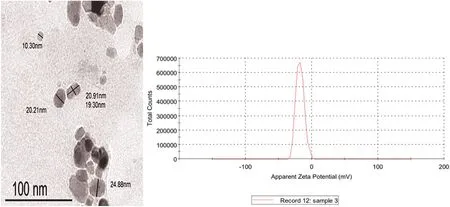
Fig.1.Nano-curcumin mean size under transmission electron microscopy and zeta potential distribution.
2.2.Experimental design
Five experimental diets (average 30.82% crude protein and 18.14 kJ/kg) were manufactured and chemical analysis was confirmed following El Basuini et al.(El Basuini et al.,2021,2022) (Table 1).Dietary Nano curcumin was incorporated in the basal diet at 0,50,100,150,and 200 ppm.
The Nile tilapia juveniles were purchased from a commercial hatchery in Kafrelsheikh governorate,Egypt and delivered to the wet laboratory of Animal and Fish Production Department,Faculty of Agriculture,Alexandria University.For acclimation,the fish were maintained in a 1000 L tank for 14 days and fed the basal feed twice on a daily basis.Two hundred and twenty-five healthy juveniles with an average primary weight of 4.39 ± 0.08 g/fish were placed in 15 glass aquaria (100 L) equipped with electric air pumps to give constant aeration.Freshly dechlorinated water for 24 h was used to replace 50%of the tank’s water regularly.Throughout the trial,the water quality was maintained regularly,with an average estimation of 21.02 ± 0.11◦C,6.73 ±0.12 mg/L,7.22 ±0.19,and 0.04 ±0.01 mg/L for temperature,dissolved oxygen,pH,and total ammonia.The experiment lasted for 56 days,which is a sufficient period for the impact of nutritional treatments(Abdel-Tawwab et al.,2017;Alagawany et al.,2021;Nguyen et al.,2019;Yonar et al.,2019).Fish were supplied the test diets twice per day at 8:00 a.m.and 4:00 p.m.at a rate of 3% of their body weight.The required feed was recalculated every two weeks based on the weight gain of the fish in each aquarium.Unconsumed diet was collected,dried,and deducted from the total feed provided during the trial to calculate feed efficiency indices as follows:
Fish mortalities,individual weight,and length were recorded to computerize the growth variables,survival rate (SR%) as follows:
Where,W56=fish weight at 56 days;W0=initial weight;N0=initial number of fish;N56=final number of fish;W=weight (g);L=fish length (cm).
2.3.Sampling procedure
Three fish were assembled from each tank (nine fish per experimental group) and sedated with 3 mL pure clove oil dissolved in 10 ml of 40% ethyl alcohol before blood,intestine,and liver sampling.Blood was drawn from the caudal vein using sterile syringes with heparin to separate plasma or without for serum separation.Three fish from each tank were allocated for dissection and assembly of the intestine and liver on the ice surface.The weight of the viscera and liver relative to the bodyweight are viscerasomatic index (VSI) and hepatosomatic index(HSI),respectively.The intestines and livers were cleaned with normal saline solution (PBS 0.90%;pH 7.5),homogenized,centrifugally separated (8000 rpm for 5 min),and the supernatant was stated at -80◦C for digestive enzymes and hepatic antioxidants assessment.
2.4.Digestive enzyme assessment
The activities of intestinal amylase and lipase were measured colorimetrically at A714 and A540 (Wang,Ishikawa,et al.,2018).Protease activity was evaluated using casein as a substrate in a Sigma non-specific protease activity protocol (Cupp-Enyard &Aldrich,2008).
2.5.Blood analysis
Sampled blood with heparin was applied for haematocrit (Ht)determination using micro-haematocrit tubes and rotary centrifugation(13000 rpm for 5 min) according to Witeska et al.(2022).Serum was separated from clotted blood samples using centrifugation at 3000 rpm undercooling (4◦C) for 10 min.Hematological and biochemical blood parameters were assessed using Semi-automatic analyzer Model 2000 Evolution,EMEG with Bayer Diagnostics kits strips according to package instructions.
2.6.Non-specific immune responses
Serum lysozyme activity (LYZ) was assessed colorimetrically at 450 nm based on the change in turbidity as detailed by Lygren et al.(1999).Briefly,10 μL of serum sample was mixed with 190 μL substrate solution(0.2 mg ofMicrococcus lysodeikticus/mL PSB,pH=7.4) into 96 microplate tubes with low agitation at lab temperature.The change in turbidity is estimated at a fixed interval of 5 min.
Serum bactericidal activity (BA) was evaluated spectrophotometrically at 570 nm following the method detailed by Gallage et al.(2016).Briefly,50 μL serum sample was mixed with 50 μL bacterial suspension(Streptococcus agalactiae1.2 ×108CFU/mL) using Wavex– Tube Rotator E11270 at 25◦C for 150 min.After incubation,mixtures were deposited into 96-microplate tubes with 15 μL of 5 ppm Thiazolyl blue (MTT) 3-(4,5-Dimethyl-2-thiazolyl)-2,5-diphenyl-2H-tetrazolium bromide (Sigma-Aldrich,Egypt) with smooth shaking to produce formazan pellets which resuspended with 50 μL of dimethyl sulfoxide (DMSO).The optical densities values of the final suspensions were measured at a wavelength of 570 and suspension without serum sample worked as a(+) control (ODcontrol).The bactericidal activity was calculated as a percentage ofS.agalactiaeinhibition compared to the (+) control as follows:
2.7.Hepatic antioxidants
Hepatic superoxide dismutase (SOD),catalase (CAT),and glutathione peroxidase (GPx) activities were quantified spectrophotometrically at 550,280,412 nm using a particular detection kit (Jian Cheng,Nanjing,China) following the producer’s guidelines.
2.8.Gastrointestinal tract microbiota
Part of the collected intestine (≃5 g/treatment) was cleaned with normal saline solution (PBS 0.90%;pH 7.5),homogenized in a sterilized mortar,and the homogenate part was transferred to a sterile 250 ml Erlenmeyer flask containing 95 mL of peptone saline (0.10% peptone;0.85% NaCl) and subjected to a gentle shake for 5 min followed by serial dilutions (10 folds).Under aseptic conditions,0.1 ml of the proper serial dilutions,as well as a blank dilution (free of the intestine sample) as a control,were spread equally with a sterile glass spreader on poured plates with different nutrients or selective media.Total bacterial count(TBC,Log CFU/g) was assessed using 0.1 mL of 10-7fold on the plate count agar (PCA) at 30◦C for 24–72 h.Similarly,total yeast and mold count (TYMC,Log CFU/g) was cultivated on potato dextrose agar (PDA)at 25◦C for 72 h.Total Coliforms were counted on a MaConkey agar using the pouring plate technique with 10-3and 10-4folds at 37◦C for 24–48 h.
Predominant bacterial genus/species colonies were classified according to the morphological characteristics of the colony including for instance shape,size,surface,edge,and color.Colonies of each recognizable taxa were counted,then three colonies of each group were cultured in tryptic soy agar (TSA) frequently until purified colonies were obtained.The isolated colonies were identified based on morphological features such as motility,flagellation,spores formation,and Gram staining in addition to different biochemical tests including catalase,oxidase,gelatinase,lipase,indole,H2S production,etc.The purified isolates were presented as a percentage of the total bacterial count(TBC).
2.9.Statistical analysis
IBM® SPSS® Inc.,IL,USA Statistics tool (IBM SPSS Statistics for Windows Version 26.0) was used to analyze the data.For variance normality and homogeneity,the Shapiro-Wilk and Levene tests were employed.The findings of the one-way ANOVA and Duncan’s post hoc test were presented as a mean of 3 replicates with standard errors of means (SEM).
3.Results
3.1.Performance variables
Growth variables,nutrient efficiency,biometric indices,and survival rates of Nile tilapia after 56 days feeding trial are presented in Table 2.Fishes exposed to low-temperature stress showed unvaried variables of growth,nutrient utilization,biometric measurement,and survival rates(P>0.05).However,the regression analysis between SGR and nano curcumin levels shows the optimum dosage of nano curcumin at 150 ppm (Fig.2).
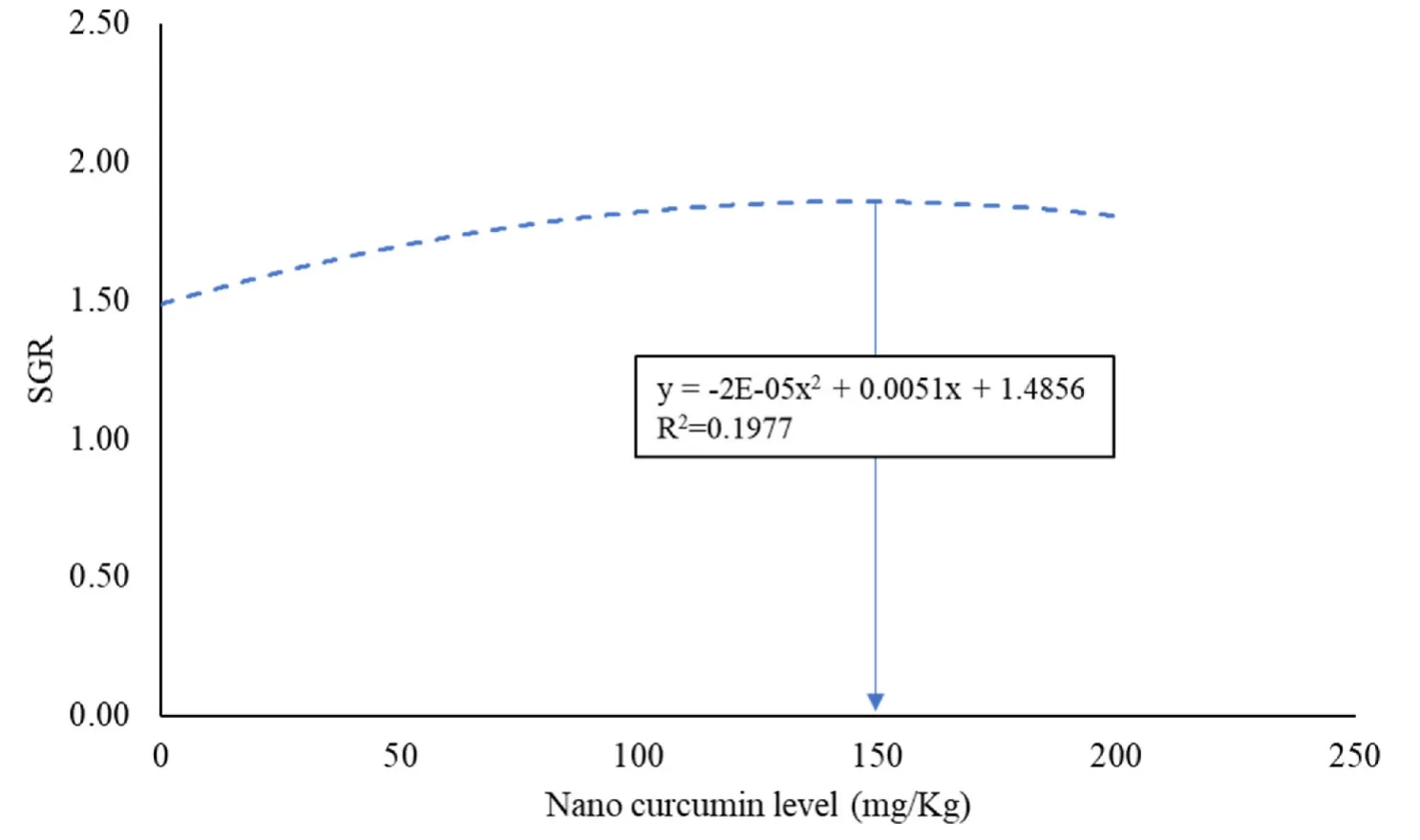
Fig.2.Regression analysis between SGR and dietary nano curcumin levels.
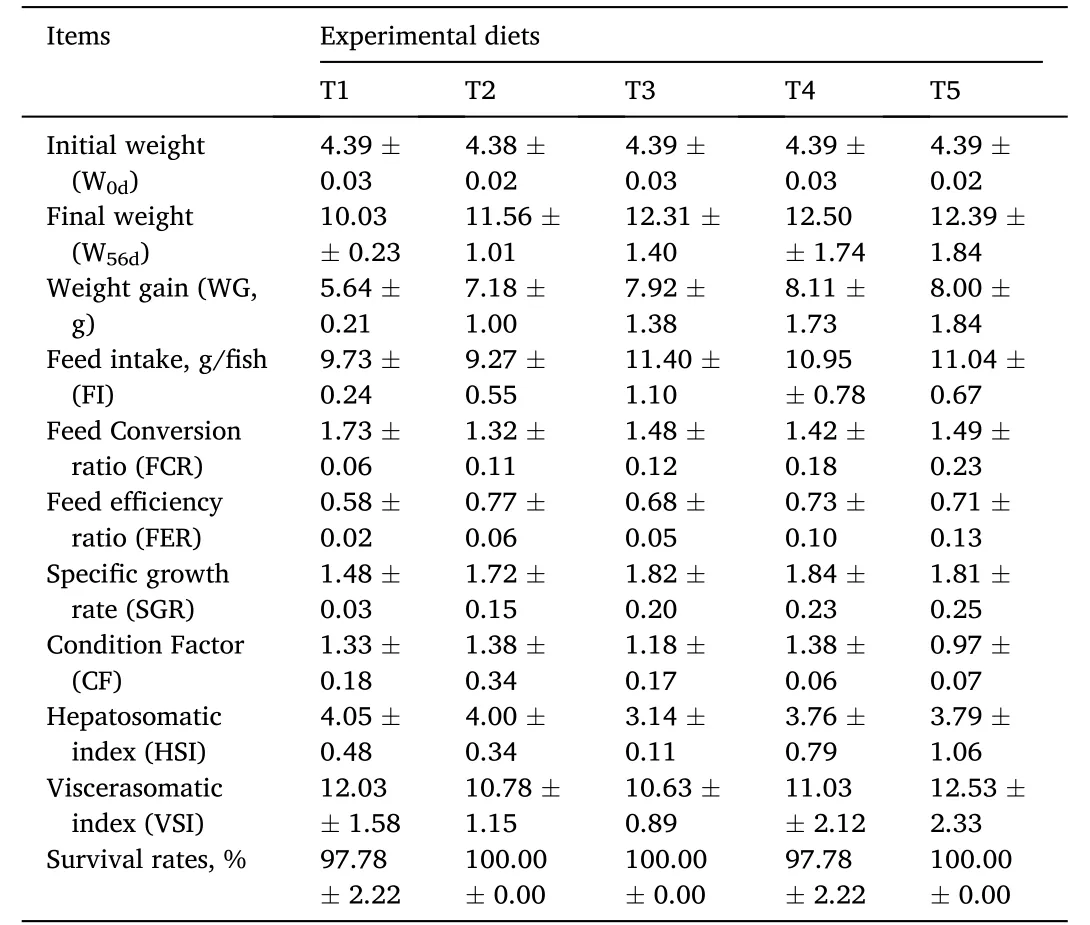
Table 2 Growth variables,nutrient efficiency,biometric indices,and survival rates after 56 days of feeding trial for Nile tilapia exposed to low-temperature stress.
3.2.Digestive enzymes
The efficiency of intestinal enzymes for Nile tilapia exposed to lowtemperature stress after 56 days of feeding trial is displayed in Table 3.No remarkable alterations occurred in the efficiency of the digestive tract enzymes with dietary Nano curcumin.
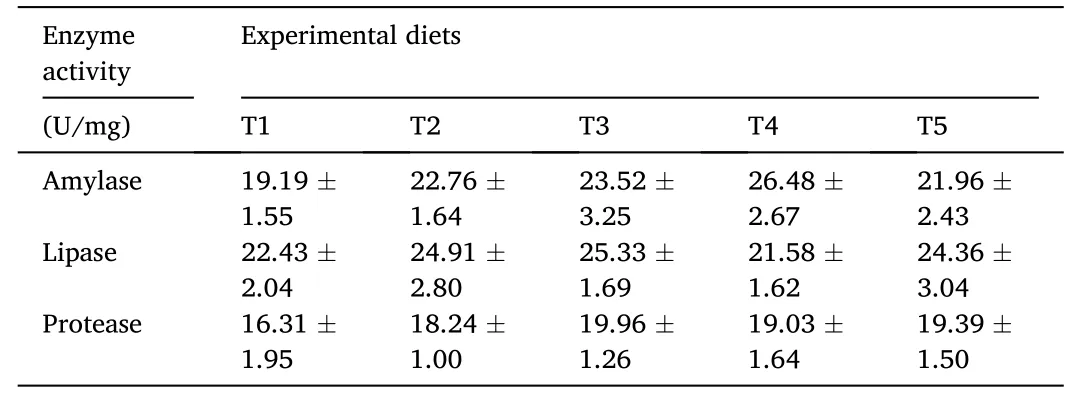
Table 3 The efficiency of intestinal enzymes for Nile tilapia exposed to low-temperature stress after 56 days of feeding trial.
3.3.Blood health
Table 4 shows the blood profile of Nile tilapia exposed to lowtemperature stress after 56 days of feeding trial.Heamatological components including haematocrit (Ht),haemoglobin (Hb),red blood cells(RBCs),and white blood cells (WBCs) exposed insignificant alteration with dietary Nano curcumin.Similarly,serum biochemists exhibited no variation in Triglyceride,Alanine transaminase (ALT),and Aspartate transaminase,while a notable modulation occurred in glucose,cortisol,total protein,and total cholesterol.Fishes treated with nano curcumin displayed higher total protein and lower glucose,cortisol,and total cholesterol compared with the control group.
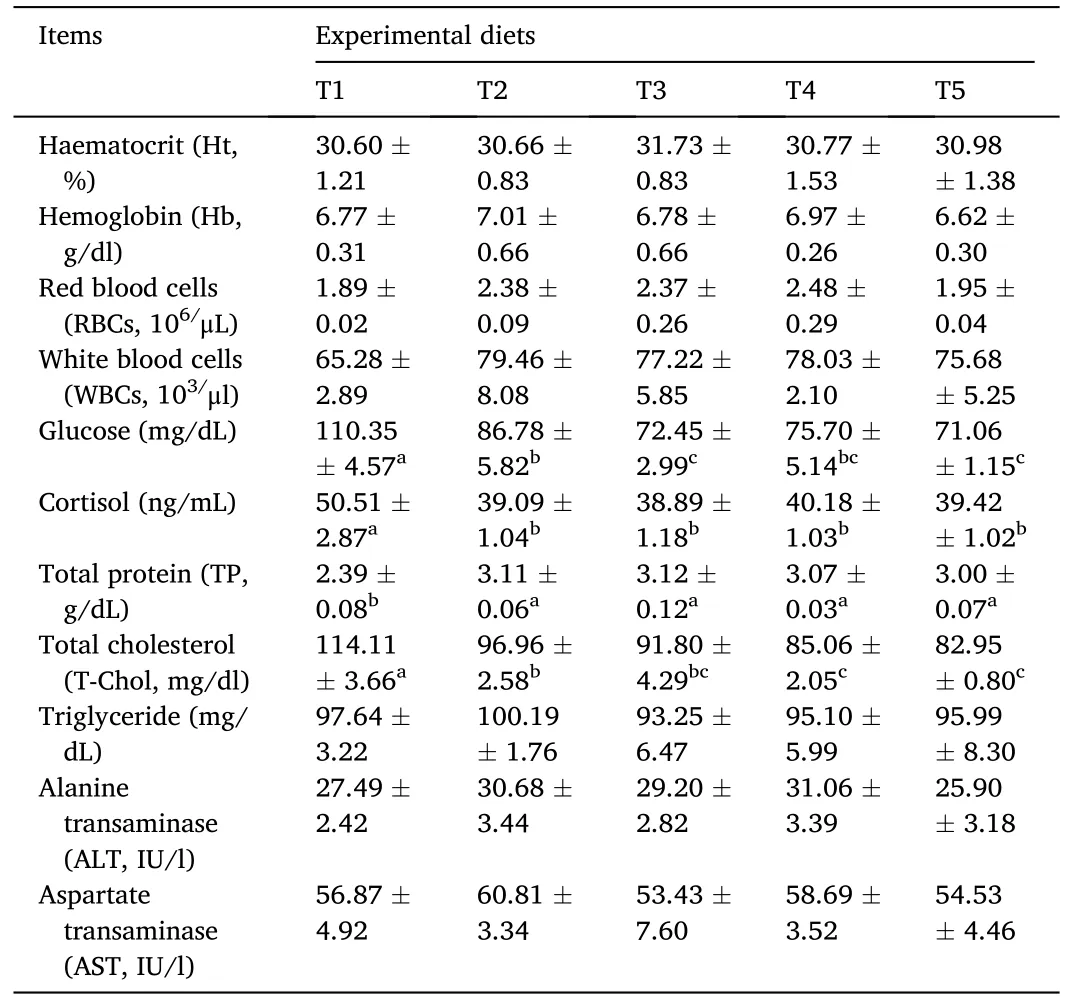
Table 4 Blood profile of Nile tilapia exposed to low-temperature stress after 56 days of feeding trial.
4.Non-specific immune responses
Lysozyme and bactericidal activities in serum of Nile tilapia exposed to low-temperature stress after 56 days of feeding trial are shown in Fig.3.Fishes fed nano curcumin diets displayed higher lysozyme and bactericidal activities compared to the control group and the best performance was found at dietary nano curcumin level of ≥100 ppm.
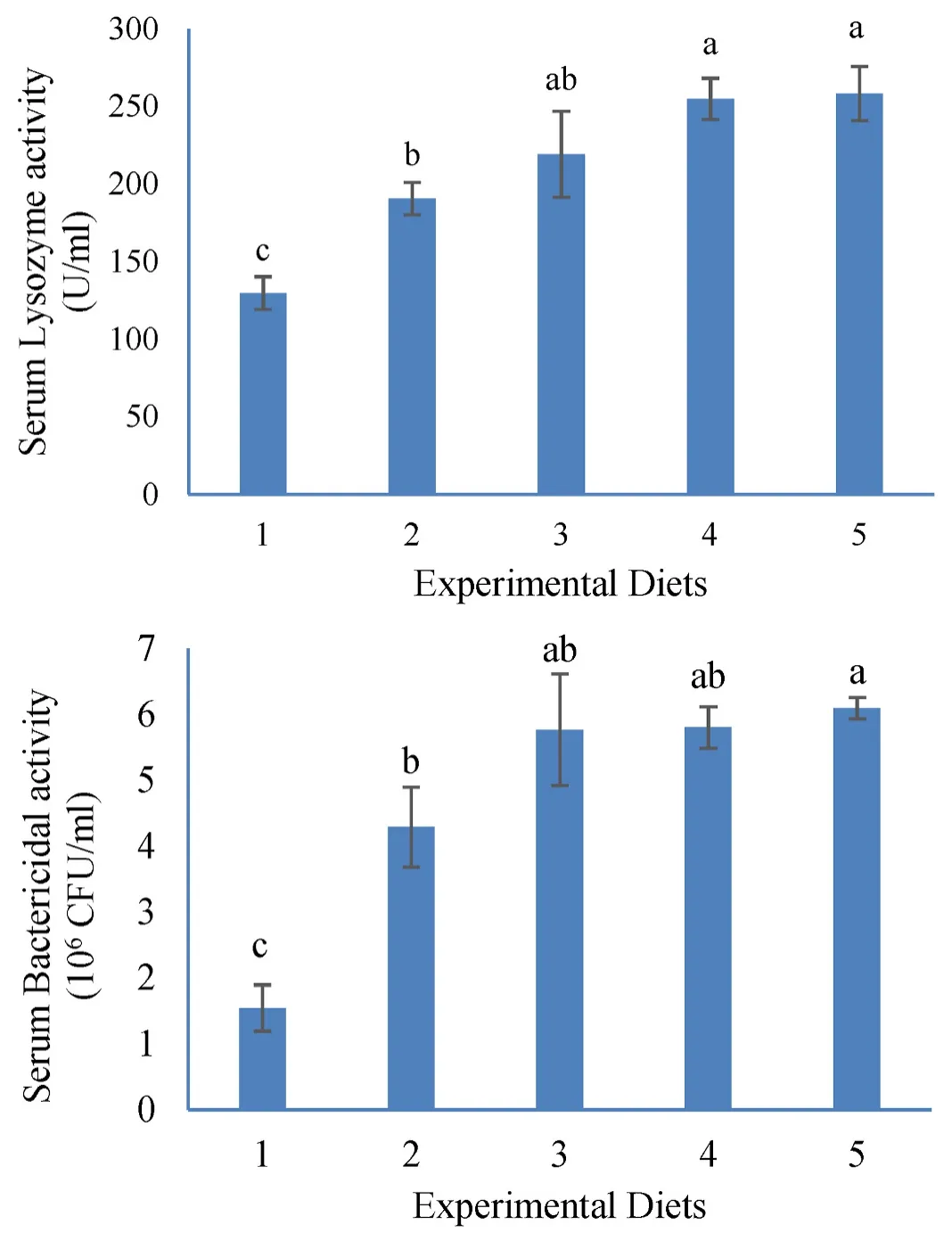
Fig.3.Lysozyme and bactericidal activities in serum of Nile tilapia exposed to low-temperature stress after 56 days of feeding trial.
4.1.Antioxidant potency
Fig.4 displays the hepatic superoxide dismutase (SOD),catalase(CAT),and glutathione peroxidase (GPx) activities in Nile tilapia exposed to low-temperature stress after 56 days of feeding trial.Fishes fed the basal diet demonstrated the poorest antioxidant capacity and the best SOD and GPx were exist in fishes fed nan curcumin diets while the best CAT efficiency occurred at higher nano curcumin levels ≥100 ppm.
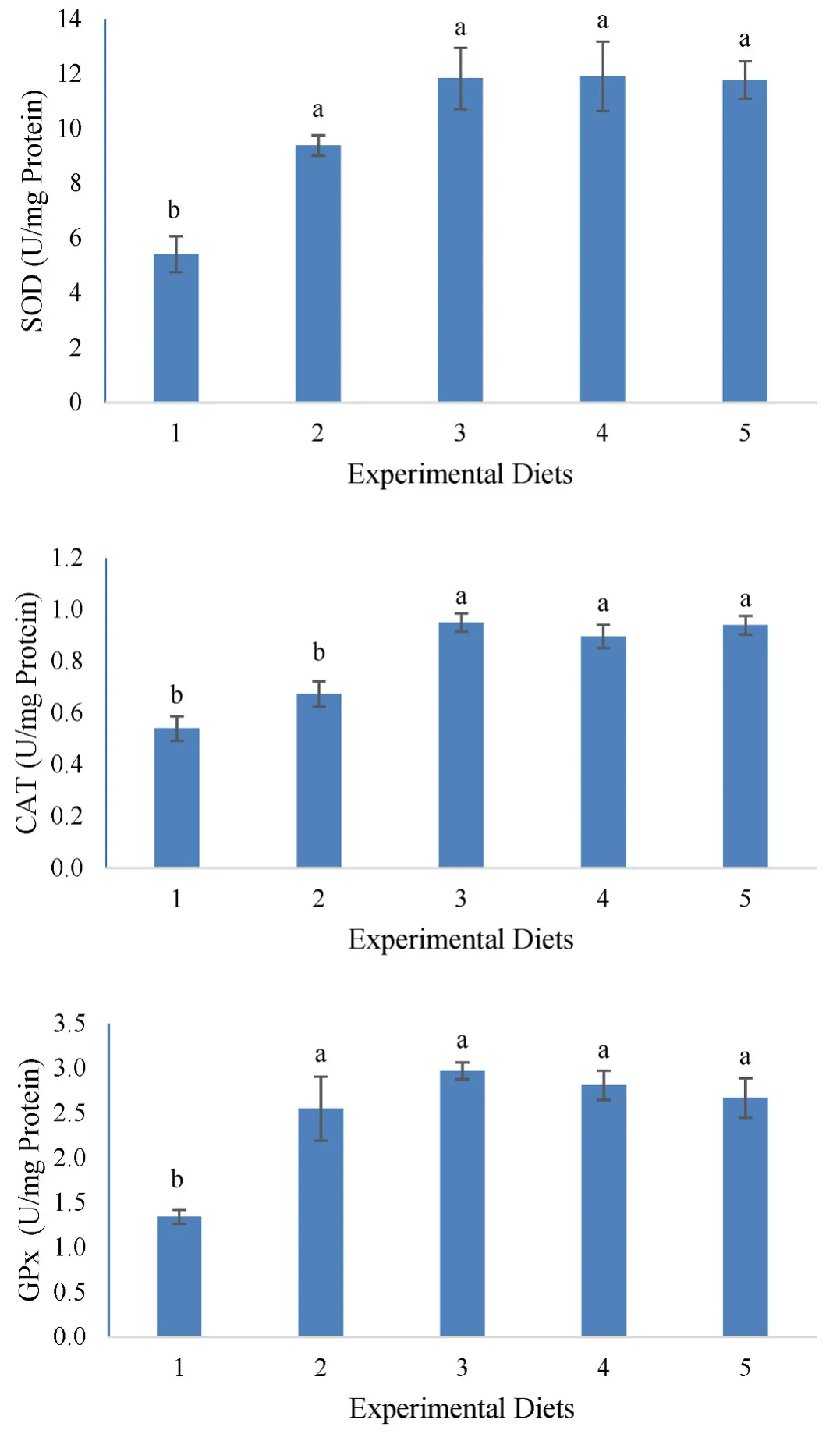
Fig.4.Hepatic superoxide dismutase (SOD),catalase (CAT),and glutathione peroxidase (GPx) activities in Nile tilapia exposed to low-temperature stress after 56 days of feeding trial.
4.2.Gastrointestinal microflora
Gastrointestinal tract microbiota of Nile tilapia exposed to lowtemperature stress after 56 days of feeding trial is provided in Table 5.Fish groups fed on nano curcumin diets displayed a noticeable alteration in flora counts and structure compared to the control.Higher microbiota counts in terms of total bacterial count (TBC),total yeast and molds count (TYMC),and coliform were found in fish fed the basal diet compared to fish fed on nano curcumin diets.No significant variation in the TBC and TYMC among nano curcumin groups meanwhile,coliform counts decline (P<0.05) with increasing nano curcumin levels in diets.The structure of gastrointestinal tract flora varies significantly among fishes fed on the experimental diets.Fishes fed the basal diet showed a higher percent ofEscherichia coli,Salmonellasp.,Shigellasp.,andStreptococcussp.,as well as a lower percentage ofBacillussp.compared to other groups.Aeromonassp.andStaphylococcussp.existence %reduce notably in fishes fed on diets that contain higher nano curcumin(≥150 ppm and ≥100 ppm,respectively).Salmonellasp.represents the highest percentage of predominated bacteria in the gastrointestinal tract,whileAeromonassp.is the least present.
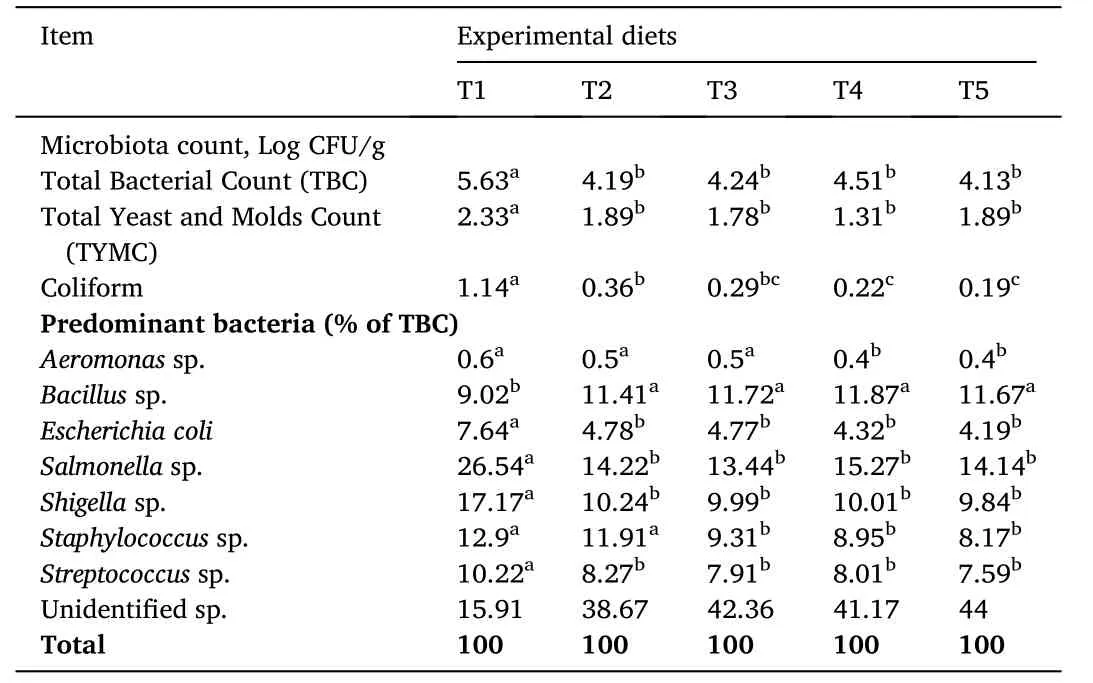
Table 5 Gastrointestinal tract microbiota of Nile tilapia exposed to low-temperature stress after 56 days of feeding trial.
5.Discussion
Aquatic animal cultivation under stressful conditions necessitates specific tactics to achieve the desired output and quality.Many ways have recently been used to boost and regulate fish growth and wellbeing e.g.,advanced farming systems,fermentation,and nutraceuticals additives (Ali et al.,2003;Dawood et al.,2018;Dossou et al.,2021;Liang &Chien,2013;Mansour &Esteban,2017).Dietary adjustment has long been recognized as a beneficial tool for improving fish performance and pathogens resistance (Oliva-Teles,2012).Curcumin is a potent therapeutic herbal product that has been studied extensively in animals and human trials (Alagawany et al.,2021;Hewlings &Kalman,2017).However,few studies have looked at the impact of curcumin on chronically stressed aquatic animals.To this objective,the Nile tilapia was selected as a worldwide model to assess the efficacy of the dietary nano curcumin under a chronic low-temperature circumstance.
The results of growth,nutrient,biometric variables,and survival rate showed no alteration in response to the nano curcumin dietary implementation.One of the explanations for the invariable growth in fish fed on experimental diets could be the constant nutrient consumption interms of feed intake (FI) and feed efficiency ratio (FER).Moreover,the convergent efficiency of the digestive enzymes explains why the utilization of nutrients remains unchanged.The present study findings differ from those of prior studies (El-Barbary,2016;Mohamed et al.,2020;Yonar et al.,2019),which showed an increase in weight and feed efficiency,and this could be due to differences in the aquatic species variables,the form and concentration of materials employed,and the experimental settings.Furthermore,the low water temperature is the logical reason for the absence of change in feeding efficiency,which was reflected in the lack of weight change between treatments.In this context,Hassan et al.(2013) acknowledged that most tilapia species flourish best at temperature between 25 and 28◦C,while reproduction stops at 22◦C and feeding declines at 20◦C.
Blood criteria are widely employed to evaluate fish’s wellbeing profile,disease states,and reaction to external stimuli.Overall,blood variables in the present trial are within the healthy ranges for Nile tilapia as described by Dawood et al.(2019).Furthermore,no significant increases in the activity of liver metabolic enzymes (ALT and AST) were detected,indicating that nano curcumin toxicity was not present at any of the studied levels.In this context,Alagawany et al.(2021) concluded that curcumin is more appealing to researchers than other phytogenic chemicals since it is safe,non-toxic,and affordable,as well as having remarkable functionality.Glucose and cortisol levels are dependable and positively markers associated with stress (Bertotto et al.,2010;Ramsay et al.,2006).Results of the present trial show a favorable decline in glucose and cortisol levels in fish-fed nano curcumin supplemented diets compared to fish provided the basal diet and this could be attributed to insulin stimulation (Hoseini et al.,2022;Sruthi et al.,2018).Similar findings were observed for cholesterol which may be linked to curcumin hypocholesterolemic impact as detected by Thota et al.(2019).On the other hand,fishes in nano curcumin groups exhibited higher levels of total protein compared to the control and this may correlate with enhanced immunity (↑ lysozyme and bactericidal activities;Fig.3) and/or antioxidants (↑ SOD,CAT,and GPx;Fig.4).Curcumin’s unique phenolic structure is responsible for its immunostimulatory,anti-inflammatory,and antioxidant properties.Similar conclusions were well-reviewed by Alagawany et al.(2021),Mahmoud et al.(2017),Pereira et al.(2020),and Yonar et al.(2019).
From a microbiological point of view,environmental,dietary,and biological factors have an impact on microbial flora (Pérez et al.,2010;Teiba et al.,2020;Teiba et al.,2020;Wong &Rawls,2012).In normal circumstances,there is a dynamic microbial balance between beneficial and harmful microbes on the surfaces of the gastrointestinal tract (GI)(Ellis,2001;Gómez &Balcázar,2008).Sustaining a healthy GI microbiota is crucial for the host body’s functions,including digestion,nutrition utilization,metabolism,and immunological regulation,as well as preventing the onset of intestinal diseases (Balcázar et al.,2006;Laparra &Sanz,2010;Rombout Jan et al.,2011).In this line,the basal diet group showed a noticeable decline in the total bacterial count when compared to other tilapia fishes that inhabit their natural environments.Al-Harbi and Uddin (2005) reported that the bacterial count of freshwater tilapia gut varied between 1.3 × 108and 1.9 × 108CFU/g.The decrease in the bacterial numbers of the control group may be attributed to the low temperature of the water in which the fish inhabit.Along with that,Hassenrück et al.(2020) reported a pronounced change in the composition and abundance of the microbiota of milkfish with temperature variations.The groups to which nano curcumin was added to their diet showed a significant decrease in the total bacterial numbers and the numbers of total yeasts and molds when compared to the group fed on the basic diet.The results also demonstrated a decrease in the bacterial count of coliform groups by more than 70% compared to the group fed the basic nutrition.Several previous studies showed the antimicrobial effect of nano curcumin against different gram-positive and gram-negative bacteria (Alagawany et al.,2021).Previous studies observed 100% inhibition ofYersinia enterocoliticawith the use of 0.2–0.7 μM doses of curcumin (Parvathy et al.,2009).The groups fed on the nano curcumin formula displayed a clear decline in the number ofE.coliandSalmonellasp.count with percent fluctuating between 37 and 45% forE.coliand 42–46% forSalmonellasp.Parvathy et al.(2009)reported that curcumin inhibited 70% of the growth ofE.coli.Similarly,different studies showed that curcumin causes inhibition ofS.aureus(Wang et al.,2016).Results obtained in our study revealed that nano curcumin exhibited moderate antimicrobial activity against different microbial groups and a highly antimicrobial effect against the coliform bacterial group.
6.Conclusion
In conclusion,incorporating nano curcumin at a level of ≥100 mg/kg diet (particularly at 150 mg/kg) improved non-specific immune responses (Lysozyme and bactericidal activities),antioxidant enzymes(SOD,CAT,GPx),and maintain healthier gastrointestinal microbiota in Nile tilapia under chronic low-temperature stress.
CRediT authorship contribution statement
Mohammed F.El Basuini:Conceptualization,Methodology,Software,Project administration,Supervision,Visualization,Writing– review &editing,Writing– original draft,Validation,Formal analysis,Resources,Data curation.Mohamed A.A.Zaki:Conceptualization,Methodology,Supervision,Visualization,Validation,Formal analysis,Resources,Data curation.Abdelaziz M.El-Hais:Conceptualization,Supervision,Validation,Data curation.Mohamed G.Elhanafy:Methodology,Validation,Formal analysis,Data curation.Emad H.El-Bilawy:Methodology,Validation,Formal analysis,Data curation.Amr I.Zaineldin:Methodology,Validation,Formal analysis,Data curation.Mohamed F.A.Abdel-Aziz:Methodology,Validation,Formal analysis,Data curation.Ibrahim A.Abouelsaad:Software,Validation,Data curation.Ibrahim T.El-Ratel:Software,Validation,Data curation.Kumbukani Mzengereza:Software,Validation,Data curation.Ronick S.Shadrack:Software,Validation,Data curation.Islam I.Teiba:Conceptualization,Project administration,Supervision,Visualization,Writing– review &editing,Writing– original draft,Validation,Formal analysis,Resources.
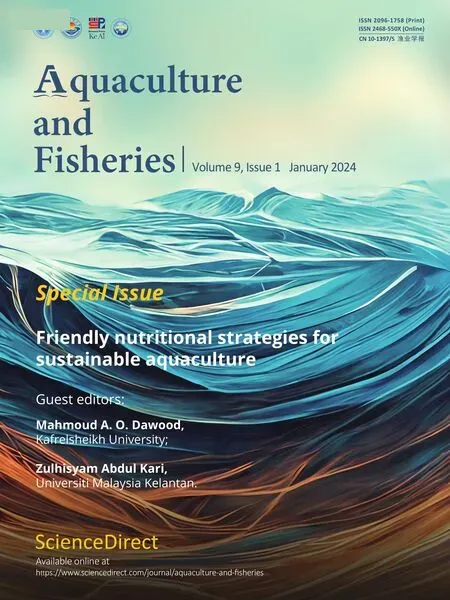 Aquaculture and Fisheries2024年1期
Aquaculture and Fisheries2024年1期
- Aquaculture and Fisheries的其它文章
- Editorial special issue: Friendly nutritional strategies for sustainable aquaculture
- Hematobiochemical and histopathological alterations in Nile Tilapia(Oreochromis niloticus) exposed to ethidium bromide: The protective role of Spirulina platensis
- Effects of Moringa oleifera aqueous extract on the growth performance,blood characteristics,and histological features of gills and livers in Nile tilapia
- Evaluation of the nutritional value of Artemia nauplii for European seabass(Dicentrarchus labrax L.) larvae
- Antioxidant effects of the aqueous extract of turmeric against hydrogen peroxide-induced oxidative stress in spotted seabass (Lateolabrax maculatus)
- Marine yeast Rhodotorula paludigena VA 242 a pigment enhancing feed additive for the Ornamental Fish Koi Carp
